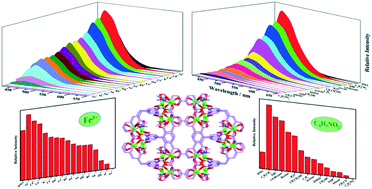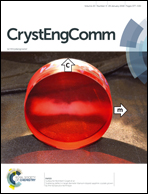Highly selective luminescence sensing for the detection of nitrobenzene and Fe3+ by new Cd(ii)-based MOFs†
Abstract
Herein, three new luminescent metal–organic frameworks (MOFs), namely {[Cd4(H3L)4(H2O)12]·2.5H2O}n (1), {[Cd(L)]·2.5H2O·3[H2N(Me)2]}n (2), and {[Cd2(L)(DMA)]·[H2N(Me)2]}n (3), were designed and successfully prepared via a solvothermal reaction using V-shaped rigid multicarboxylate 2,4-di(3′,5′-dicarboxylphenyl)benzoic acid (H5L) and Cd(II) salts in various solvent systems. The structural analyses indicated that the H3L2−/L5− ligands took three different coordination fashions in 1–3; this resulted in a diversity of targeted MOFs. The solid-state luminescence properties of three MOFs were studied under ultraviolet light irradiation at ambient temperature, and 3 showed a high selectivity and sensitivity for nitrobenzene and Fe3+ because of the quenching effect. Thus, it could be a potential crystalline material for detecting these substances. The mechanisms of the quenching effect and sensing properties of 3 have been discussed in detail.



 Please wait while we load your content...
Please wait while we load your content...